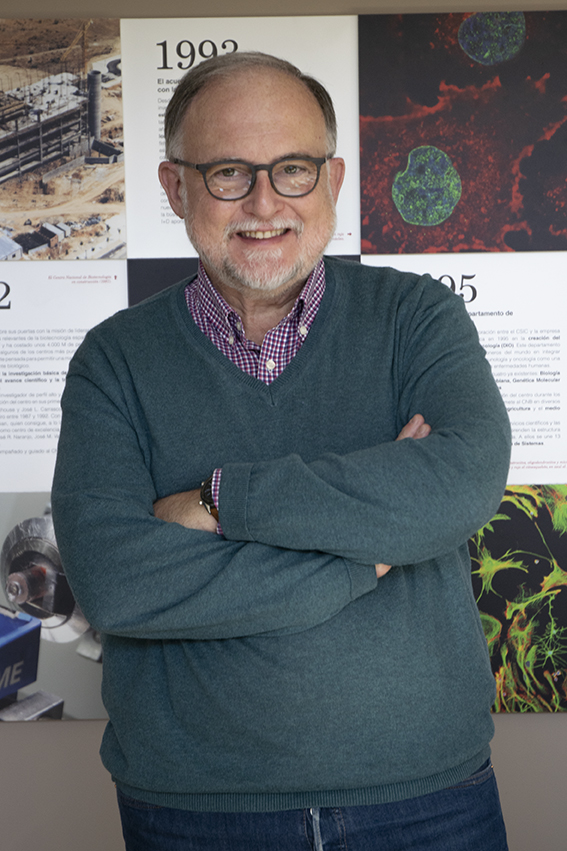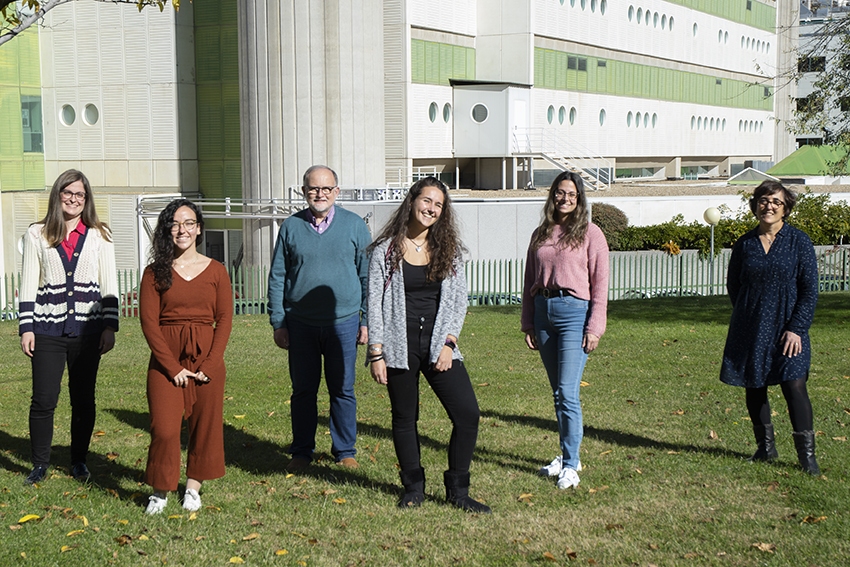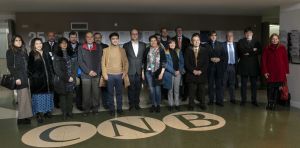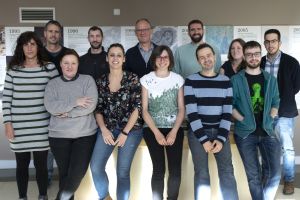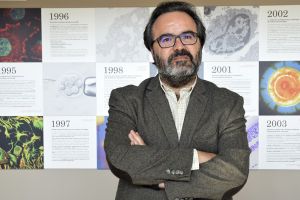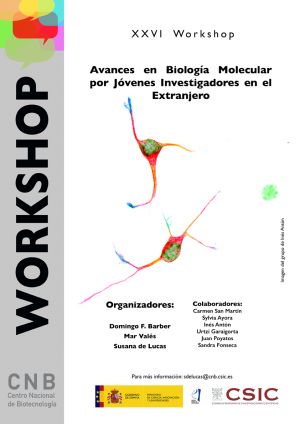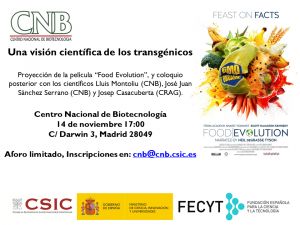The call to apply for the Introduction to Research JAE-CSIC scholarships is opened. These scholarships are specially aimed to university students in the last year of their university degree. The duration of the fellowship is for 5 consecutive months, with the option to start either in September or October 2019.
The National Center for Biotechnology offers up to 28 places in this call:
Abstract
Bacillus subtilis ParB forms multimeric networks involving non-specific DNA binding leading to DNA condensation. Previously, we found that an excess of the free C-terminal domain (CTD) of ParB impeded DNA condensation or promoted decondensation of pre-assembled networks (Fisher et al., 2017). However, interpretation of the molecular basis for this phenomenon was complicated by our inability to uncouple protein binding from DNA condensation. Here, we have combined lateral magnetic tweezers with TIRF microscopy to simultaneously control the restrictive force against condensation and to visualise ParB protein binding by fluorescence. At non-permissive forces for condensation, ParB binds non-specifically and highly dynamically to DNA. Our new approach concluded that the free CTD blocks the formation of ParB networks by heterodimerisation with full length DNA-bound ParB. This strongly supports a model in which the CTD acts as a key bridging interface between distal DNA binding loci within ParB networks.
Rafael Giraldo
Group Leader
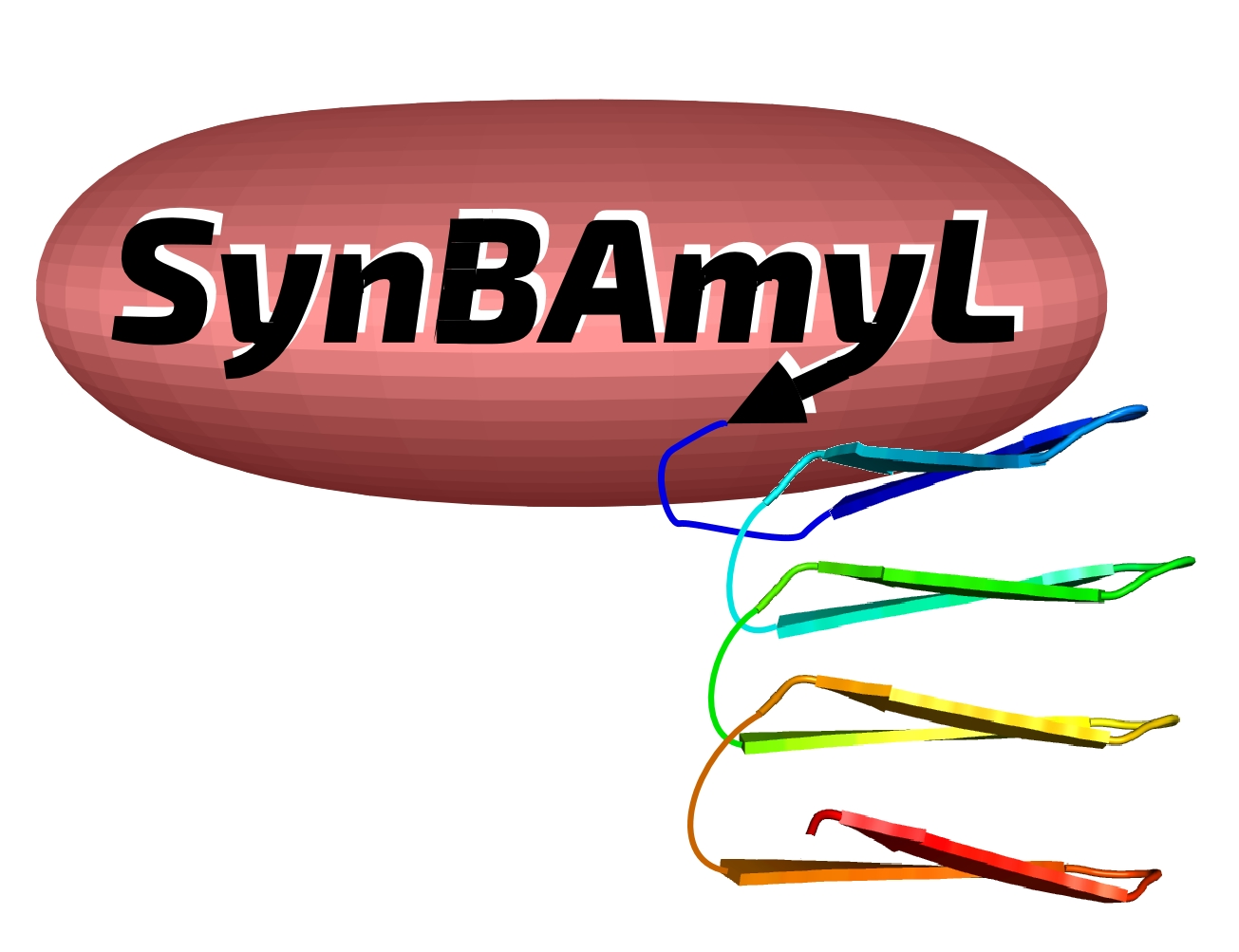
Amyloids are stable protein assemblies that regulate phenotypes and enable their epigenetic inheritance. However, when they are the outcome of protein misfolding, amyloids can trigger diseases (i.e., human neurodegenerative and systemic amyloidosis). We create, through bottom-up Synthetic Biology, bio-resources based on bacterial amyloids with two major aims: i) understanding the molecular determinants of the shift between function and toxicity in natural amyloids; and ii) generating new devices based on amyloids as constructive resources in Biotechnology and Biomedicine.
Publications
Vendrell-Fernández S, Lozano-Picazo P, Cuadros-Sánchez P, Tejero-Ojeda MM, Giraldo R. Conversion of the OmpF porin into a device to gather amyloids on the E. coli outer membrane. ACS Synth Biol 2022; 11:655-667
Pantoja-Uceda D, Oroz J, Fernández C, de Alba E, Giraldo R, Laurents DV. Conformational priming of RepA-WH1 for functional amyloid conversion detected by NMR spectroscopy. Structure 2020; 28: 336-47.
Revilla-García A, Fernández C, Moreno-del Álamo M, de los Ríos V, Vorberg IM, Giraldo R. Intercellular transmission of a synthetic bacterial cytotoxic prion-like protein in mammalian cells. mBio 2020; 11: e02937-19.
Giraldo R. SynBio and the boundaries between functional and pathogenic RepA-WH1 bacterial amyloids. mSystems 2020; 5: e00553-20.
Giraldo R. Optogenetic navigation of routes leading to protein amyloidogenesis in bacteria . J Mol Biol 2019; doi: 10.1016/j.jmb.2019.01.037
Fernández C, Giraldo R Modulation of the aggregation of the prion-like protein RepA-WH1 by chaperones in a cell-free expression system and in cytomimetic lipid vesicles. ACS Synth Biol 2018; 7: 2087-2093
RepA is a protein essential for the maintenance of plasmids in Gram-negative bacteria whose WH1 domain undergoes conformational changes capacitating it either as a transcriptional repressor, as DNA replication initiator or, through its assembly into amyloid oligomers, to hinder premature re-replication rounds. Stable RepA-WH1 dimers become metastable amyloidogenic monomers upon allosteric binding of plasmid-specific dsDNA sequences, or acidic phospholipids. We have engineered fusions of mutant variants of RepA-WH1 to the fluorescent protein mCherry, generating a prion-like protein (prionoid) that is epigenetically transmitted from mother-to-daughter Escherichia coli cells under the modulation of the Hsp70 chaperone DnaK, causing a synthetic ‘generic’ amyloid proteinopathy. In the bacterial cytosol, RepA-WH1 aggregates as distinct strains, either dense foci or fluidized particles, which exhibit acute and mild cytotoxicity, respectively. RepA-WH1 amyloidosis recapitulates in bacteria the mitochondrial route in human amyloid diseases, including the formation of oligomeric pores at the internal membrane, the generation of reactive oxygen species and the co-aggregation of stress-responsive factors. We have demonstrated that RepA-WH1 can be horizontally transmitted to mammalian cultured cells, but its cytotoxicity depends on its heterologous expression in the recipient cells (Fig. 1A).
We have used RepA-WH1 as a benchmark for the design of synthetic tools to probe protein amyloidogenesis, including gold nanoparticles-based sensors and screening devices exploiting amyloid-promoted overriding of translation termination, both in yeast and in bacteria. We have also achieved control on RepA-WH1 amyloidogenesis through optogenetics, i.e., the fusion of a blue light-responsive plant domain (LOV2) to WH1. Under illumination, a LOV2-WH1-mCherry fusion assembles as oligomers that are cytotoxic in E. coli, hampering bacterial growth (as novel antimicrobial ‘optobiotics’), while in the darkness it forms inert amyloid fibrils and hydrogels (Fig. 1B).
Our latest development is engineering the E. coli outer membrane porin OmpF by grafting an amyloidogenic sequence in its extracellular loop L5, thus enticing to the bacterial envelope, through the assembly of amyloids, the same sequence when presented as a free peptide or in its protein of origin. Targeting bacteria to amyloids opens a way to the bioremediation of prions persistent in natural environments (Fig. 1C).

Figure legend. A bacterial protein ‘moonlighting’ as a functional amyloid (RepA-WH1, panels A and B) can be either engineered as a minimal model of amyloid disease (A), or tailored to modulate amyloid toxicity with light constituting a potential antimicrobial agent (B). Bacterial outer membrane porins (OmpF, panel C) can be converted into scavengers of environmental amyloids.
.
Una delegación de CEIM Confederación empresarial Madrid-CEOE ha visitado hoy el Centro Nacional de Biotecnología (CNB-CSIC) en un encuentro organizado por la Fundación General CSIC (FGCSIC), donde han conocido los avances en investigaciones biotecnológicas relacionadas con la biomedicina, la agricultura sostenible y bioremediación ambiental que se están llevando a cabo desde el Consejo Superior de Investigaciones Científicas (CSIC).
ACS Applied Materials & Interfaces
Raquel Mejías, Patricia Hernández Flores, Marina Talelli, José L. Tajada-Herráiz, Maria Brollo, Yadileiny Portilla, María del Puerto Morales, and Domingo F. Barber
Abstract
Magnetic hyperthermia has a significant potential to be a new breakthrough for cancer treatment. The simple concept of nanoparticle-induced heating by the application of an alternating magnetic field has attracted much attention, as it allows the local heating of cancer cells, which are considered more susceptible to hyperthermia than healthy cells, while avoiding the side effects of traditional hyperthermia. Despite the potential of this therapeutic approach, the idea that local heating effects due to the application of alternating magnetic fields on magnetic nanoparticle-loaded cancer cells can be used as a treatment is controversial. Several studies indicate that the heating capacity of magnetic nanoparticles is largely reduced in the cellular environment due to increased viscosity, aggregation and dipolar interactions. However, an increasing number of studies, both in vitro and in vivo, show evidence of successful magnetic hyperthermia treatment on several different types of cancer cells. This apparent contradiction might be due to the use of different experimental conditions. Here we analyze the effects of several parameters on the cytotoxic efficiency of magnetic nanoparticles as heat inductors under an alternating magnetic field. Our results indicate that cell-nanoparticle interaction reduces the cytotoxic effects of magnetic hyperthermia, independently of nanoparticle coating and core size, the cell line used and the subcellular localization of nanoparticles. However, there seems to occur a synergistic effect between the application of an external source of heat and the presence of magnetic nanoparticles, leading to higher toxicities than those induced by heat alone, or the accumulation of nanoparticles within cells.
For the fifth consecutive year, Roberto Solano, researcher at Centro Nacional de Biotecnología is the list of the most cited researchers in the Plant &Animal Science area published by Clarivate Analytics.
The EMBO Journal (2018) e99552
Cristina Martínez, Ana Espinosa‐Ruíz, Miguel de Lucas, Stella Bernardo‐García, José M Franco‐Zorrilla, Salomé Prat.
Abstract
The Arabidopsis PIF4 and BES1/BZR1 transcription factors antagonize light signaling by facilitating co‐activated expression of a large number of cell wall‐loosening and auxin‐related genes. While PIF4 directly activates expression of these targets, BES1 and BZR1 activity switch from a repressive to an activator function, depending on interaction with TOPLESS and other families of regulators including PIFs. However, the complexity of this regulation and its role in diurnal control of plant growth and brassinosteroid (BR) levels is little understood. We show by using a protein array that BES1, PIF4, and the BES1‐PIF4 complex recognize different DNA elements, thus revealing a distinctive cis‐regulatory code beneath BES1‐repressive and PIF4 co‐activation function. BES1 homodimers bind to conserved BRRE‐ and G‐box elements in the BR biosynthetic promoters and inhibit their expression during the day, while elevated PIF4 competes for BES1 homodimer formation, resulting in de‐repressed BR biosynthesis at dawn and in response to warmth. Our findings demonstrate a central role of PIF4 in BR synthesis activation, increased BR levels being essential to thermomorphogenic hypocotyl growth.
En el CNB nos sumamos a la celebración de la Semana de la Ciencia 2018 el día 14 de noviembre a partir de las 5 de la tarde. Trás la proyección de la película documental Food evolution, se realizará un coloquio posterior con los científicos Lluís Montoliu y José Juan Sánchez Serrano, del Centro Nacional Biotecnología (CNB) Madrid y Josep Casacuberta, del Centre for Research in Agricultural Genomics (CRAG), Cerdanyola.
Food evolution es un documental dirigido por Scott Hamilton Kennedy y narrado (en inglés) por Neil de Grass Tyson. La película, con subtítulos en castellano, muestra la controversia que rodea al uso de organismos modificados genéticamente como alimentos, abordando el debate surgido entre científicos y consumidores sobre cómo alimentar a nuestra población en expansión de manera segura y sostenible.
Dirección: Centro Nacional Biotecnología, C/Darwin 3 (Campus Cantoblanco), Madrid 28049.
Fecha 14 de noviembre, 17:00, salón de actos
Aforo: 50 personas
COOKIES POLICY
A cookie is a text file that is stored on your computer or mobile device via a web server and only that server will be able to retrieve or read the contents of the cookie and allow the Web site remember browser preferences and navigate efficiently. Cookies make the interaction between the user and the website faster and easier.
General information
This Website uses cookies. Cookies are small text files generated by the web pages you visit, which contain the session data that can be useful later in the website. In this way this Web remembers information about your visit, which can facilitate your next visit and make the website more useful.
How do cookies?
Cookies can only store text, usually always anonymous and encrypted. No personal information is ever stored in a cookie, or can be associated with identified or identifiable person.
The data allow this website to keep your information between the pages, and also to discuss how to interact with the website. Cookies are safe because they can only store information that is put there by the browser, which is information the user entered in the browser or included in the page request. You can not run the code and can not be used to access your computer. If a website encrypts cookie data, only the website can read the information.
What types of cookies used?
The cookies used by this website can be distinguished by the following criteria:
1. Types of cookies as the entity that manages:
Depending on who the entity operating the computer or domain where cookies are sent and treat the data obtained, we can distinguish:
- Own cookies: are those that are sent to the user's terminal equipment from a computer or domain managed by the editor itself and from which provides the service requested by the user.
- Third party cookies: these are those that are sent to the user's terminal equipment from a machine or domain that is not managed by the publisher, but by another entity data is obtained through cookies.
In the event that the cookies are installed from a computer or domain managed by the editor itself but the information collected by these is managed by a third party can not be considered as party cookies.
2. Types of cookies as the length of time that remain active:
Depending on the length of time that remain active in the terminal equipment can be distinguished:
- Session cookies: cookies are a type designed to collect and store data while the user accesses a web page. Are usually used to store information that only worth preserving for the service requested by the user at any one time (eg a list of products purchased).
- Persistent cookies: cookies are a type of data which are stored in the terminal and can be accessed and treated for a period defined by the head of the cookie, and can range from a few minutes to several years.
3. Cookies types according to their purpose:
Depending on the purpose for which the data are processed through cookies, we can distinguish between:
- Technical cookies: these are those that allow the user to navigate through a web page or application platform and the use of different options or services it exist as, for example, control traffic and data communication, identify the session, access to restricted access parts, remember the elements of an order, make the buying process an order, make an application for registration or participation in an event, use security features while browsing store content for dissemination videos or sound or share content via social networks.
- Customization cookies: these are those that allow the user to access the service with some general characteristics based on a predefined set of criteria in the user terminal would eg language, the type of browser through which you access the service, the locale from which you access the service, etc.
- Analysis cookies: they are those that allow the responsible for them, monitoring and analyzing the behavior of users of the web sites that are linked. The information gathered through such cookies are used in measuring the activity of web sites, application or platform and for the profiling of user navigation of such sites, applications and platforms, in order to make improvements function data analysis how users use the service.
Management tool cookies
This Website uses Google Analytics.
Google Analytics is a free tool from Google that primarily allows website owners know how users interact with your website. Also, enable cookies in the domain of the site in which you are and uses a set of cookies called "__utma" and "__utmz" to collect information anonymously and reporting of website trends without identifying individual users..
For statistics of use of this website use cookies in order to know the level of recurrence of our visitors and more interesting content. This way we can concentrate our efforts on improving the most visited areas and make the user more easily find what they are looking for. On this site you can use the information from your visit for statistical evaluations and calculations anonymous data and to ensure the continuity of service or to make improvements to their websites. For more details, see the link below privacy policy [http://www.google.com/intl/en/policies/privacy/]
How to manage cookies on your computer: disabling and deleting cookies
All Internet browsers allow you to limit the behavior of a cookie or disable cookies within settings or browser settings. The steps for doing so are different for each browser, you can find instructions in the help menu of your browser.
If you decline the use of cookies, since it is possible thanks to the preferences menu of your browser or settings, reject, this website will continue to function properly without the use of the same.
Can you allow, block or delete cookies installed on your computer by setting your browser options installed on your computer:
- For more information about Internet Explorer click here.
- For more information on Chrome click here.
- For more information about Safari click here.
- For more information about Firefox click here.
Through your browser, you can also view the cookies that are on your computer, and delete them as you see fit. Cookies are text files, you can open and read the contents. The data within them is almost always encrypted with a numeric key corresponding to an Internet session so often has no meaning beyond the website who wrote it.
Informed consent
The use of this website on the other hand, implies that you paid your specific consent to the use of cookies, on the terms and conditions provided in this Cookies Policy, without prejudice to the measures of deactivation and removal of cookies that you can take, and mentioned in the previous section.

